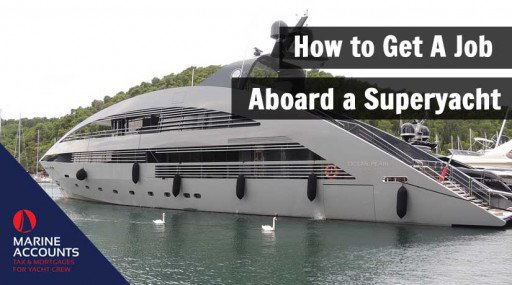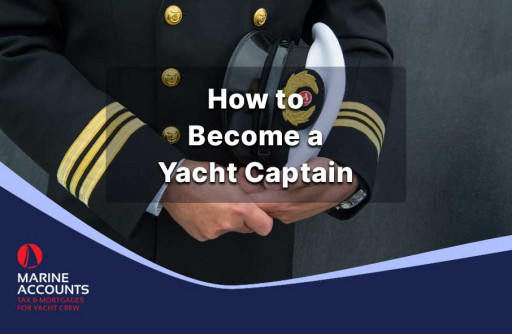Gambling in England: Balancing Tradition, Innovation, and Responsibility
- Authors
-
-

- Name
- Patrick Maflin
-
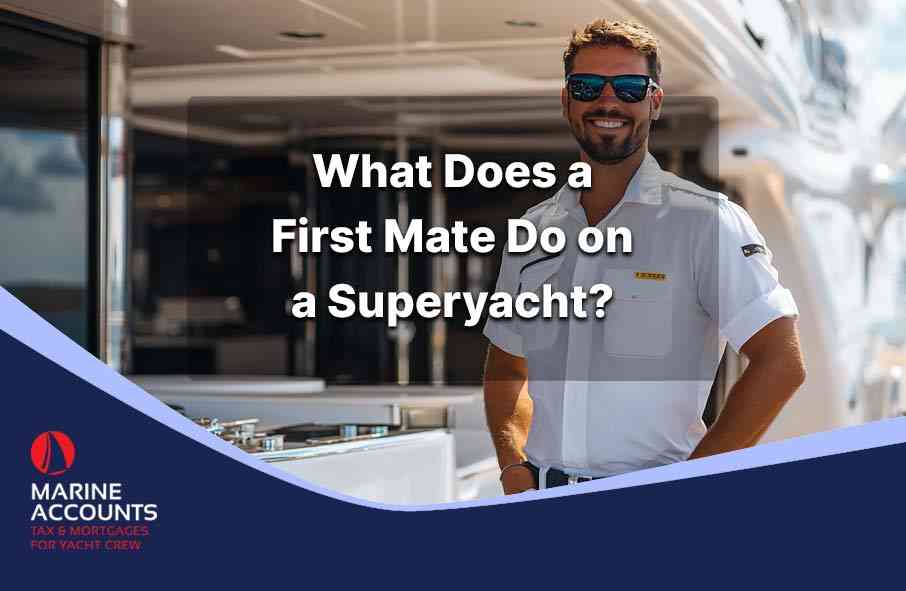
Imagine the shimmering blue sea, the gentle sway of a superyacht gliding across the waves, and the serene calm that only the open ocean can provide.
Behind every luxurious voyage, there’s a skilled team making everything run smoothly.
While the captain is typically the star of the show, the first mate, also commonly known as the first officer, is often the backbone of yacht operations.
If you've ever wondered what a first mate does on a superyacht, this article will take you through their vital role, responsibilities, qualifications, and more.
Whether you aspire to get a job in yachting or are just curious about life at sea, this guide will leave you with a deeper understanding of the essential role the first mate plays in yachting.
Chapters
- What is a First Mate (First Officer)?
- What Does a First Mate Do on a Yacht?
- First Mate Qualifications
- How to Become a First Mate on a Yacht
- How Much Does a First Mate Earn?
- Conclusion
What is a First Mate (First Officer)?
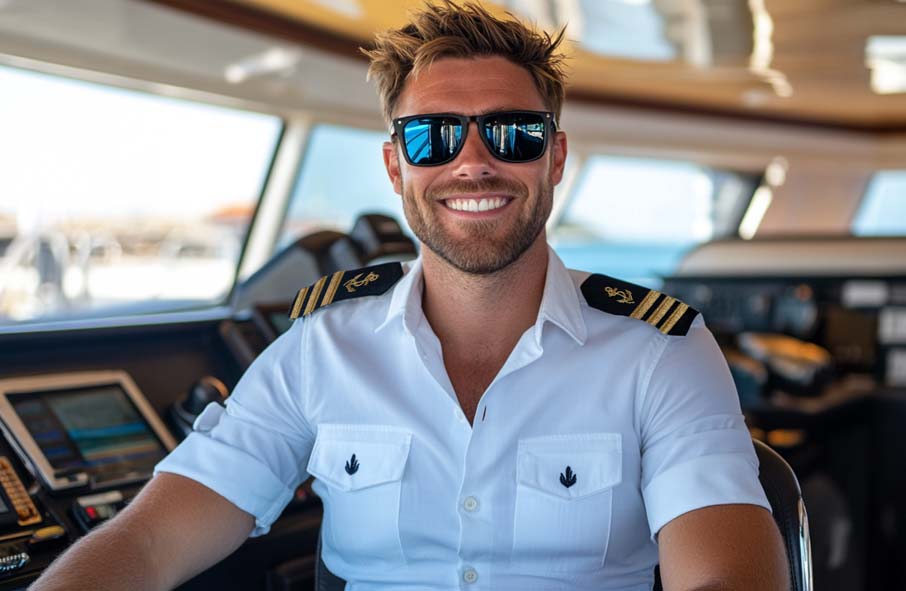
A first mate, sometimes referred to as the first officer, is second in command on a superyacht, just below the captain.
The first mate is responsible for a wide range of duties that keep the yacht safe, operational, and enjoyable for guests.
This position requires not only technical skills but also excellent leadership and the ability to multitask under pressure.
The first mate coordinates the deck crew, handles navigation responsibilities, and ensures that the captain’s orders are carried out effectively.
In a sense, the first mate is the captain’s right-hand person.
They often act as a bridge between the captain and the rest of the crew, helping to maintain smooth operations while the yacht is both anchored and underway.
What Does a First Mate Do on a Yacht?
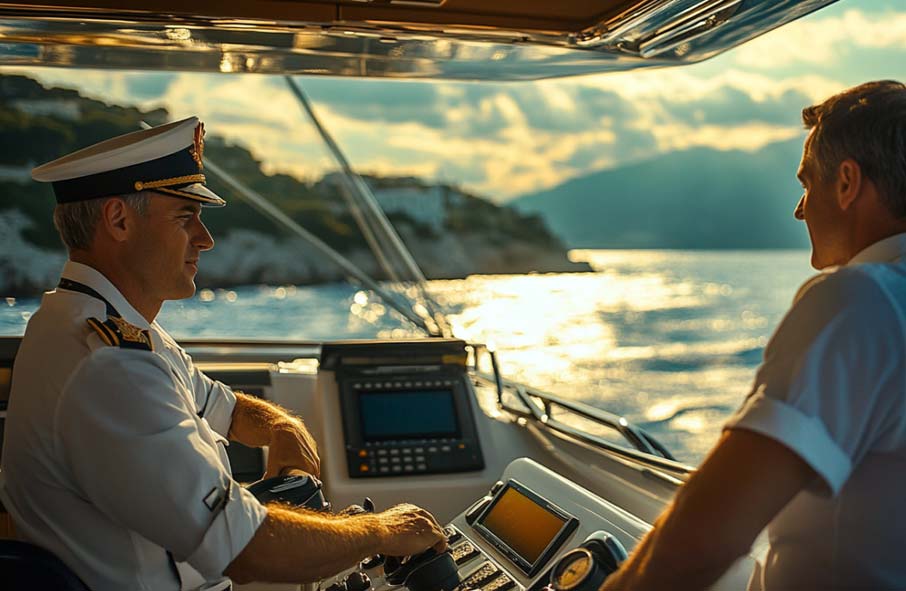
The role of a first mate on a superyacht is multifaceted and crucial to the successful operation of the vessel.
Their responsibilities span a wide range of tasks, from navigation to crew management.
Let’s break down some of the key duties:
Assist Captain with Yacht Operations & Maintenance
The first mate assists the captain with all operational aspects of the yacht, including planning the voyage, maintaining the vessel, and ensuring it's in top condition.
This includes regular inspections, checking for any mechanical or structural issues, and arranging necessary maintenance.
A well-maintained yacht is essential for safety and efficiency, making this one of the first mate’s most critical duties.
Oversee Deck Crew Duties
On a superyacht, the first mate is in charge of the deck crew.
This team handles a range of tasks, including cleaning and maintaining the exterior of the yacht, assisting with docking and anchoring, and ensuring the yacht’s equipment is always operational.
The first mate oversees their daily duties, coordinates their schedules, and ensures that they perform tasks to the highest standard.
They are also responsible for training new crew members and conducting regular safety drills.
Navigation & Watch-keeping
Navigation is another core responsibility of the first mate.
They help plot the course, monitor the yacht’s position, and work closely with the captain to avoid hazards.
This requires a deep knowledge of maritime navigation, weather patterns, and sea conditions.
When the yacht is in transit, the first mate often stands watch, overseeing the yacht’s position, keeping an eye on nearby vessels, and ensuring the yacht remains on course.
Maintain Charts, Navigation & Safety Equipment
Maintaining the yacht’s navigation and safety equipment is another essential duty.
The first mate is responsible for ensuring that charts are up-to-date, that navigational instruments are calibrated, and that all safety equipment, including life rafts and fire extinguishers, is operational.
Safety is paramount at sea, so the first mate routinely inspects equipment and trains the crew in emergency procedures.
Handle Guest Requests & Complaints
On a luxury superyacht, guest satisfaction is a top priority.
The first mate frequently interacts with guests, answering questions, handling requests, and addressing complaints as needed.
They must be personable, attentive, and capable of handling issues diplomatically.
In the world of luxury yachting, it’s essential to provide a seamless and pleasant experience for guests, and the first mate plays a crucial role in achieving this.
Stand in During Captain’s Absence
The first mate is the primary point of contact if the captain is unavailable or needs to take a break.
In these cases, the first mate steps up to manage the yacht and make decisions to ensure smooth operations.
This requires strong leadership, quick decision-making skills, and a clear understanding of all yacht functions.
The first mate must be ready to take command and navigate any challenges that may arise.
First Mate Qualifications
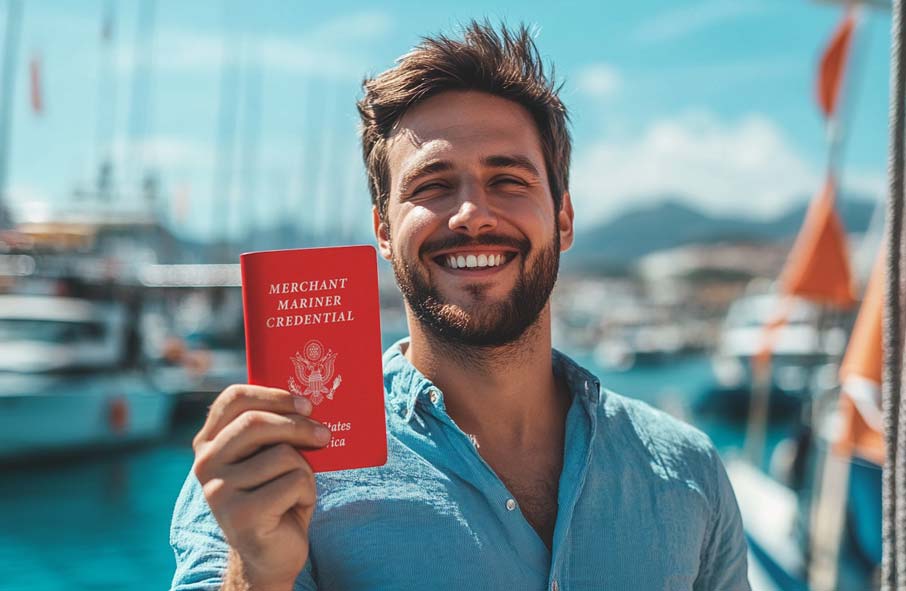
Becoming a first mate on a superyacht requires specific qualifications and certifications.
Here are some of the key qualifications expected for this role:
Merchant Mariner Credential (MMC)
The Merchant Mariner Credential (MMC) or an equivalent qualification is mandatory document for all mariners.
It certifies that the holder meets professional standards and has passed necessary exams.
This credential is recognised internationally, making it a valuable qualification for first mates who may work on superyachts worldwide.
Chief Mate 500gt / USCG 500-ton License
For first mates on larger superyachts, a Chief Mate 500gt or U.S. Coast Guard (USCG) 500-ton license is often required.
This license qualifies mariners to serve as chief officers on vessels up to 500 gross tons.
Obtaining this license involves rigorous training, exams, and sea-time requirements.
Several Years Yachting Experience
Experience is crucial for a first mate position.
Most first mates have several years of experience working in various roles on yachts, from deckhands to bosuns.
This hands-on experience helps build the skills needed to handle the first mate’s wide-ranging responsibilities effectively.
ENG 1 Medical Certificate
The ENG 1 medical certificate is a maritime health clearance that ensures crew members are physically fit to work at sea.
It’s a required certification for most superyacht crew members, as life on a yacht can be physically demanding.
The certificate must be renewed periodically to ensure ongoing fitness.
STCW Basic Safety Training
The STCW (Standards of Training, Certification, and Watchkeeping) Basic Safety Training is a fundamental requirement for all seafaring professionals.
This training covers essential safety practices, such as firefighting, first aid, and personal survival techniques.
It’s a prerequisite for nearly all roles on a yacht, and it ensures that the crew is prepared for emergencies.
How to Become a First Mate on a Yacht
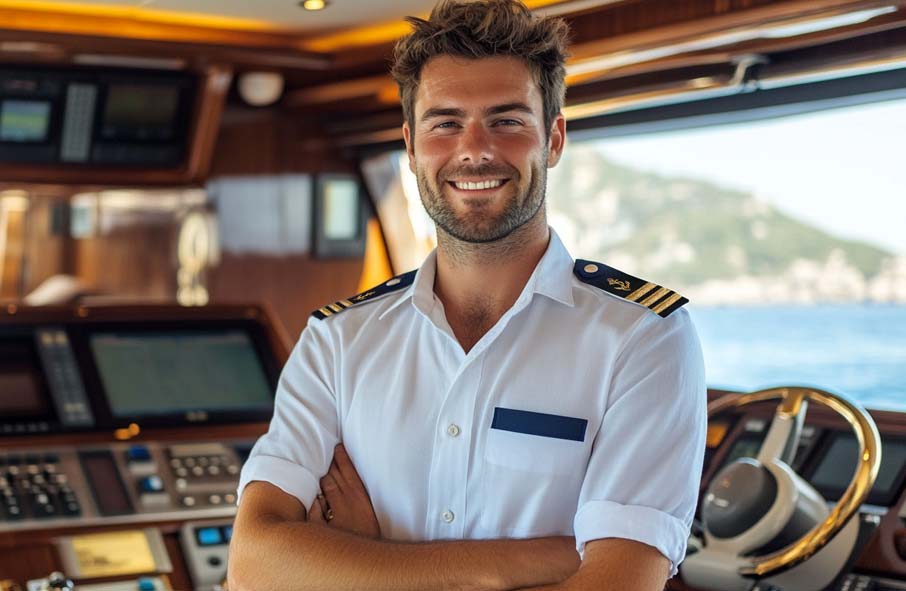
Becoming a first mate on a superyacht typically involves starting in entry-level positions, such as a deckhand or steward, and working up through the ranks.
Here are the steps commonly taken to become a first mate:
- Gain Experience: Start with entry-level roles and accumulate sea-time hours.
- Complete STCW Training: Obtain the necessary safety certifications.
- Build Credentials: Work towards licenses and certifications like the MMC and the 500-ton license.
- Develop Skills: Build leadership, navigation, and maintenance skills.
- Network: Networking in the yachting industry can help you find opportunities for advancement.
Each of these steps helps aspiring first mates build the experience, qualifications, and reputation needed to step into a first mate role on a superyacht.
How Much Does a First Mate Earn?

Salaries for first mates on superyachts vary depending on factors such as the yacht’s size, location, and the individual’s experience level.
Typically, first mates earn between $5,000 to $10,000 per month, with some on larger and more luxurious yachts earning upwards of $12,000 per month.
Many of these positions also come with perks like accommodation, meals, travel allowances, and sometimes even bonuses for exceptional performance.
One of the standout benefits of working as a first mate, or in any qualifying offshore role, is the potential for tax-free income.
In the UK, first mates who meet the HMRC Seafarers Earnings Deduction requirements can avoid paying income tax on their salary.
This deduction is available to seafarers who work outside the UK for more than 183 days within a single tax year and meet other specific criteria related to residence and qualifying voyages.
For US citizens, a similar benefit is available through the IRS Foreign Earned Income Exclusion.
This provision allows Americans working offshore to exclude a certain amount of foreign earnings from their taxable income (up to a specified threshold, which adjusts annually).
To qualify, a first mate must meet either the physical presence test (living and working outside the US for at least 330 days within a 12-month period) or the bona fide residence test, which applies to those who establish residence in a foreign country for an entire tax year.
These tax exclusions make a career at sea particularly financially attractive.
For first mates who meet the residency requirements, the potential to earn a tax-free salary not only boosts their take-home pay but also adds to the allure of working offshore.
The combination of high earning potential and tax-free income makes the first mate role not only adventurous but also extremely rewarding financially.
Conclusion
The role of a first mate on a superyacht is both dynamic and rewarding, combining leadership, technical skill, and a deep commitment to safety and service.
From overseeing the deck crew and maintaining navigational systems to assisting the captain with complex operations, a first mate is essential to the smooth running of any yacht.
This challenging position demands a blend of experience, qualifications, and dedication, but for those passionate about yachting, the rewards are significant.
In addition to competitive salaries, first mates can benefit from tax advantages such as the SED or the FEIE, potentially making their income tax-free if they meet specific offshore residency requirements.
These unique financial perks, combined with the adventure of a life at sea, make the first mate role one of the most exciting and financially advantageous careers on the water.
For those who thrive in demanding, team-focused environments and seek a career offering both adventure and opportunity, working as a first mate on a superyacht could be the perfect fit.
Disclaimer: Any advice in this publication is not intended or written by Marine Accounts to be used by a client or entity for the purpose of (i) avoiding penalties that may be imposed on any taxpayer or (ii) promoting, marketing or recommending to another party matters herein.


